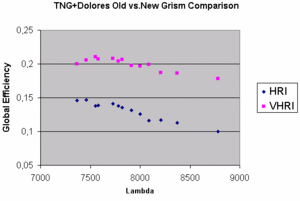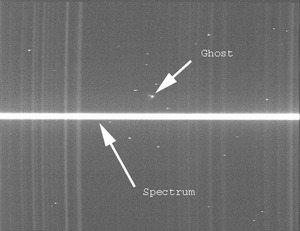New Volume Phase Holographic Grisms installed on DOLORES
During the first week of October 2005, a set of 9 Volume Phase Holographic
(VPH) Grisms were installed on Dolores and successfully commissioned. The
grisms used in Dolores were assembled and laboratory-tested by the Golem group
(Brera-INAF Observatory in Milan).
Since July 2001, one experimental VPH grism (centered on the H_Alpha) was
regularly used in Dolores and its superior performances indicated that this
would have been the natural evolution for a serious up-grade of Dolores.
Thanks to their higher-than-average efficiency, the spectroscopic
capabilities of the TNG at optical wavelenghts are now improved by at least a
factor of ~50%.
Moreover, the highest resolving power of Dolores increased now up to Rs~5000,
to be compared with the former Rs~3000.
Three of the new VPHs do replace exactly (both in wavelegth coverage and
resolution) the old grisms: HR-V, HR-R and HR-I.
These grisms were thus christened: VHR-V, VHR-R and VHR-I, the preceeding
"V" indicating that they are VPHs.
The remaining 6 grisms were choosen to cover ~600-800 Angstrom intervals
centered on emission/absorption lines of particular interest in astrophysics
(see Table 1).
| V390 | V486 | V510 | V589 | V656 | V860 | VHRV | VHRR | VHRI | |
|---|---|---|---|---|---|---|---|---|---|
|
O3727 4000 |
HeII 4670 H? 4861 |
OIII 5007 Mg5200 |
Na D 5890 |
Ha 6563 | Ca 8600 | / | / | / | |
| gr/mm | 1511 | 2040 | 1886 | 1600 | 1400 | 1060 | 566 | 660 | 685 |
| Eff. Lmed | 0.85 | 0.77 | 0.81 | 0.84 | 0.86 | 0.86 | 0.80 | 0.81 | 0.85 |
| Lmin | 3600 | 4550 | 4850 | 5590 | 6200 | 8100 | 4650 | 6200 | 7360 |
| Lmax | 4200 | 5000 | 5350 | 6200 | 6920 | 9100 | 6800 | 7800 | 8900 |
| Rs | 3100 | 5200 | 5100 | 4700 | 4550 | 4300 | 1480 | 2430 | 2950 |
The response of the new VPH grisms was measured by observing a
spectrophotometric star during a stable and photometric night.
Since the grism wheel has only 11 usable positions,for the test it was decided
to mount all the new VPHs and leave the old HR-I to do a one-to-one comparison
with its equivalent VPH.
The global efficiency of the TNG+Dolores+Grism with both the old HR-I and the new VHR-I is shown in Figure 1.

Figure1: Plot of the global efficiency of the system TNG+Dolores+Grism as measured from a standard star.
At 7550 Angstroms, the TNG+Dolores global efficiency was 0.14 with the old
HR-I and is 0.21 with the new VHR-I, a notable ~50% improvement.
Almost all the new VPHs, with the exception of V510 and V390, do have a
little ghost above or below the spectrum , as shown in Figure 2.
It should be noted, however that the reddest VPHs (i.e. V860, VHR-R and
VHR-I) suffer of significant second-order effect.
For observations it is recommended to couple them with the ~520 nm cut-on
filter
(
Rasmussen Filter #2 )
available on the filters wheel.

Figure 2: The typical ghost which affects almost all the VPH grisms. In this case the spectrum taken with V656 is shown.
The New Dolores Configuration
Starting from January 1st 2006, the Dolores grisms configuration will be
modified according to the scheme shown in Table 2.
Note that, since the pyramid focuser is also mounted on the grism wheel,
not all the VPHs will be available at the same time on Dolores.
Starting from AOT-14, observers can also request those VPHs that are normally
not mounted on the instrument (e.g. V390, V589) but ONLY in visitor mode.
| OLD CONFIGURATION | NEW CONFIGURATION |
|---|---|
| LR-B | LR-B |
| LR-R | LR-R |
| MR-B | MR-B |
| MR-I | V486 |
| HR-B | V510 |
| HR-V | V656 |
| HR-R | V860 |
| HR-I | VHR-V |
| Rasmussen | VHR-R |
| VPH-Halpha | VHR-I |

